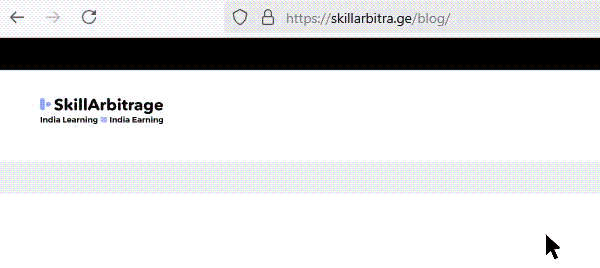This article is a detailed, step-by-step guide to scissor marketing, a polarizing brand positioning strategy that splits a crowded market in two and wins you the half that matters. You willl learn how to craft scissor statements that force people to pick sides, collapse noisy categories, and trigger buyer urgency. Perfect for Indian freelancers helping clients in competitive niches stand out, convert faster, and dominate on message alone.
Table of Contents
Previously on Introduction to Scissor Statements…
Raja dropped a blade into the crowded skincare market, a polarizing truth that split Yamini’s audience clean in half. While others begged for attention, he showed how to provoke allegiance by forcing a choice.
But tension alone isn’t power. In this article, Raja sharpens the scissor into a marketing weapon. With Swathi and Raghunandan in tow, he reveals how to collapse categories, ignite loyalty, and win the only half of the market that matters.
(Continued…)
The sun outside was unforgiving, frying pavement and patience alike. Inside, the air was thick with bergamot and unfinished moodboards.
Swathi lay sprawled on the studio sofa, hair in a knot, phone in one hand, and iced espresso in the other. She glanced at Raja, who sat across from her, hunched over his screen.
“So,” she said, not looking up from her phone, “did she ghost you already? Or is your dating life also ‘frozen hiring for the time being’?”
Raja didn’t bite. Just kept scrolling.
“Hmm? Hmm? Hmm?” Swathi was relentless when she wanted goss.
“She got me a meeting,” he said finally.
Swathi raised an eyebrow without lifting her gaze.
“A meeting? With HR? Her dad? Meeting with who?”
“Nope,” Raja said, still scanning his inbox. “With Yamini Kamat.”
That name landed like a rock on a glass sculpture.
Swathi sat up sharply.
“Yamini Skinworks?”
“Yep.”
Her espresso suddenly seemed very far away.
“As in… Yamini Kamat from NIFT? The Yamini Kamat, who almost failed footwear design and now owns half the internet’s face serum budget?”
“The one and only,” said Raja. “Savitha works for her.”
Swathi blinked. Once. Twice.
“Wait…your date, Savitha?”
“Yes, my date, Savitha,” Raja said, grinning now.
From the far corner, a rustle of pages stopped mid-turn. Raghunandan looked up from his sketchpad like a meerkat who’d overheard something worth living for.
“You have a girlfriend?” He said, already getting up.
Before Raja could protest, Raghunandan had plonked himself down next to Swathi, feet on the table like he owned shares in the conversation.
A second later, Parvathishankar entered, holding a book he clearly hadn’t read a word of in the last ten minutes.
“I heard ‘meeting’ and ‘girlfriend’ in the same sentence,” he said, settling onto the armchair like a man prepared to moderate a very unserious panel.
Swathi rolled her eyes. “It wasn’t a romantic meeting. Apparently, our very own wordsmith here just landed a pitch with Yamini Kamat.”
Parvathishankar’s eyebrows rose. “Yamini Skinworks? The one with the waterless serum ads on Instagram?”
Swathi nodded, jaw tight. “The same. My batchmate. My rival. And now Raja’s prospect.”
Parvathishankar gave a slow, approving nod. “Ah. The plot thickens like cold ghee.”
“And what exactly,” Swathi asked slowly, “did you pitch to the skincare queen?”
“Scissor marketing,” Raja said, like it explained everything.
Swathi blinked. “What even is that?”
“Well,” said Raja, leaning back. “I showed up with a blade.”
“Jesus.” Raghunandan winced.
Swathi narrowed her eyes.
“Okay, poet boy. Start making sense.”
Raja tapped the side of his temple.
“Scissor statements,” he said. “The kind that don’t persuade. They divide. They force a choice. No fence-sitting. No middle.”
Raghunandan frowned. “That a new kind of D2C analytics or something?”
“No,” Raja said. “It’s war.”
He looked around the room now, enjoying the sudden gravity.
“It’s how you split a market. Cut it clean down the middle and win the half that matters.”
Swathi crossed her arms, the corners of her mouth twitching between disbelief and reluctant intrigue.
“So you’re selling division now?”
“I’m selling clarity,” Raja said. “In a world that worships mush.”
She set her coffee down like a gauntlet.
“Alright, tell me everything.”
Parvathishankar leaned forward, fingers steepled. “Go on.
1. Crowd will kill you
Raja didn’t wait for approval. He was mid-rant, mid-flame, and the room could either keep up or get scorched.
“So here’s the truth,” he said, pacing slowly. “The crowd will kill you. Try to please everyone and you end up with nothing but beige mush. Consensus is a coffin for brands.”
Swathi looked unsure. “Isn’t that a bit… extreme?”
Death of neutrality in a world of noise
Raja didn’t flinch. “Extremes are where attention lives. The middle is where brands go to die quietly.”
Parvathishankar, silent till now, arched an eyebrow. He was listening. Not to dismiss, but to measure the weight of what Raja was building. The boy wasn’t just thinking out loud anymore. He was sharpening weapons.
Neutrality is a slow death
“You think neutrality is safe?” Raja asked, looking directly at Swathi. “It’s a slow bleed. You don’t even realize you’re dying until your relevance is six feet under.”
Swathi pushed back. “But isn’t neutrality… responsible? Especially for a brand with a diverse customer base?”
Parvathishankar spoke, voice even. “Sometimes, there’s merit to temperance. Sometimes the wise path is the quiet one.”
Raja turned to him, respectful but unafraid. “Parvathi uncle, you taught me how to listen. Now let me show you how to roar.”
Parvathishankar’s lips curled into the faintest of smiles. He didn’t interrupt again.
Rise and fall of consensus-driven campaigns
Raghunandan, ever the analyst, joined in. “You’re saying the middle ground is the most dangerous place to be?”
Raja nodded. “Look at all the consensus-driven campaigns that collapsed. ‘Don’t offend’ becomes ‘don’t matter.’ If you’re not willing to say something that repels the wrong people, you’ll never attract the right ones.”
Swathi wasn’t convinced. “But what if it backfires? What if this gets my classmate’s brand canceled?”
Raja’s eyes flicked toward her. “Swathi, Yamini Skinworks isn’t a startup peddling hope. It’s a brand in a mature, saturated market. She’s earned the right to make waves.”
“But earned from whom?” Swathi pressed. “You really think her audience will survive the shock?”
Raja answered coolly. “If they don’t, then they were never her real audience. This tactic isn’t for the faint-hearted or the unproven. It’s for brands that are tired of surviving and ready to command.”
A blade you must earn the right to wield
He leaned on the table now, voice low but tight with conviction.
“This isn’t for everyone. If you’re still getting your first thousand customers, this will break you. If you’re still unsure who you are, it’ll snap you in half.”
“But,” he said, locking eyes with each of them, “if your brand has already proven itself, if you’re surrounded by copycats, if the market’s drowning in sameness, then this blade is your birthright. You don’t cut the market by being kind. You cut it by being clear.”
Tactic: Run a ‘contrarian death audit’
Swathi exhaled. “Alright, rebel. Let’s say I’m on board. Where do we start?”
Raja smiled. The room had turned. They weren’t just hearing him now. They were following.
“You run a Contrarian Death Audit. Pull up your last five campaigns. Ask one question: What were we too scared to say? What truth were we whispering when we should’ve been shouting?”
He paused. “That thing you’re scared to post? That’s the scissor. That’s what divides the market. That’s what makes you unforgettable.”
Parvathishankar finally spoke. “It’s dangerous advice.”
Raja shrugged. “So is staying silent.”
2. What is a scissor statement?
They were still in the glass conference room. The city outside yammered on. Inside, the silence thickened.
Swathi was eyeing Raja like he was holding a lit match near a can of petrol.
Art of forcing a fracture
“You’re serious about dropping this on Yamini?” she asked. “You realize she’s my classmate. If this blows up, it’ll take her brand and my friendship with her.”
“She’s not a startup anymore,” Raja replied. “She’s earned the right to make enemies.”
Difference between heat and fracture
He picked up a marker and wrote in bold:
SCISSOR STATEMENT
“A controversial statement generates heat,” Raja said. “A scissor statement causes a fracture. It’s not about outrage. It’s about forcing people to pick a side.”
“Sounds reckless,” Swathi muttered.
“If done badly,” he said.
Parvathishankar interjected, “Where did you even get this idea?”
Raja grinned. “You’ll like this.”
Origins: From toxoplasma to the scissor
“It started with a blog called Slate Star Codex. A blog run by a tech philosophy guy named Scott Alexander. Internet goldmine. One of his essays, The Toxoplasma of Rage, explained how the most controversial idea always wins in visibility. Not the smartest. Not the kindest. The one that splits the room and forces people to post.”
“Lovely,” Swathi said. “You’re basing brand strategy on internet rage.”
“Wait,” Raja said, “that’s not even where the term comes from.”
He turned to the board and wrote:
Sort by Controversial, the short story.
“Scott wrote a fictional piece years later called Sort by Controversial. In it, two people read a sentence. One says it’s obviously true. The other says it’s obviously false. And they both think anyone who disagrees is evil. That’s the scissor statement.”
“So, it’s engineered identity warfare,” Raghunandan said.
“Exactly,” Raja said. “The moment people can’t stay neutral, the scissor starts cutting.”
What powers a scissor statement
Raja drew a triangle and labeled the corners:
- Identity Violation
- Mimetic Desire
- Status Threat
“These three are the fuel. You violate who someone thinks they are. You expose what they want because others want it. And you tell them their status is fragile.”
Swathi exhaled. “So this isn’t messaging. This is psychological warfare.”
Raja didn’t flinch. “In a crowded market, attention is the battlefield.”
Real-world tension: Heritage vs. hype
“Here’s a candidate for Yamini,” he said, writing it slowly:
If your skincare isn’t rooted in your heritage, it’s just Western residue in a nicer bottle.
Swathi inhaled sharply. “You’re going to have the entire ‘clean beauty’ crowd after her.”
“Good,” Raja said. “Because the other half will rally. They’ll say, finally, someone said it.”
Parvathishankar studied him. “I once told Raghunandan, ‘A great brand doesn’t need to shout. It needs to stand still so the right people find it.’”
Raja nodded. “Yeah. And sometimes, to stand still, you have to burn the map everyone else is following.”
Parvathishankar’s eyes narrowed, then softened. He said nothing.
Tactic: Test it with the binary emotion grid
Raghunandan leaned over the table. “So how do you know a line has that power before it’s too late?”
Raja drew a 2×2 grid and titled it:
Binary Emotion Grid
| Feel Good | Feel Bad | |
| Agree | Superfan | Cultist |
| Disagree | Hater | Nemesis |
“You’re looking for spike emotions,” Raja said. “If it sits in the middle, kill it. If people either clutch it or crucify it, you’ve got a scissor.”
Swathi looked at the grid. “So you want Yamini to be a saint to some and a sinner to others?”
3. Forbidden fights your industry won’t touch
The room still pulsed from Raja’s revelation. The idea had landed like a blade on butter.
Swathi rubbed her temples. “You realize she might actually say it now. That line. In public.”
Expose the idea that no one dares speak aloud
Raja didn’t blink. “Good. She’s earned the right.”
Parvathishankar, half-amused, asked, “And what gave her that right?”
“A decade of trust,” Raja replied. “Her customers believe her. That gives her the license to question what no one else dares touch.”
What’s the thought everyone’s tiptoeing around?
Raghunandan leaned forward. “Alright. Say someone else wants to try this. Where do they start?”
Raja grabbed a marker and wrote:
What’s the question your industry tiptoes around like a minefield?
He let it hang.
“It’s not about attacking a person or trend,” he said. “It’s about spotlighting the belief everyone’s built their careers on but no one’s had the guts to test.”
Cults begin with a challenger
Raja leaned forward, his voice low but intense. “Exactly. Take the ad wars between the Hindu and the Times of India in 2011. The Hindu didn’t just defend itself. It retaliated by cutting deeper, not at what TOI said, but at who TOI readers believed they were.”
He flicked to a slide showing the iconic Times of India (ToI) ad: “Stuck with news that puts you to sleep? Wake up to the Times of India.”
“ToI swung first with a category-level insult. The Hindu’s response wasn’t about news, it was about intellect, identity, and self-respect,” Raja continued, his eyes narrowing. “They didn’t say, ‘We’re better.’ They said, ‘If you choose ToI, this is who you are. And ending with ‘Stay ahead of the Times’’”
He clicked to the next slide: The Hindu’s ad, showing people failing at basic general knowledge, followed by their confident knowledge of Bollywood trivia. “That’s the cut that matters. It wasn’t about the product. It was about the people consuming it.”
Parvathishankar raised an eyebrow. “So they weren’t defending their content. They were defending their readers.”
“Exactly,” Raja said, a smirk tugging at his lips. “This is textbook scissor warfare. Don’t attack the product. Attack the premise. Don’t defend your style. Reframe the stakes. Make it about identity, not the content.”
He paused, letting the words sink in.
“Think of it like this: The Hindu wasn’t trying to win everyone. They were calling their tribe to war and humiliating the other tribe into silence. It wasn’t about persuading people to switch sides. It was about defining who’s with them and who’s not.”
Parvathishankar leaned in, sensing where Raja was going. “And that’s what Yamini Skinworks needs to do against Glowby, right?”
“Exactly,” Raja replied. “Look, Glowby and Yamini Skinworks are already the two market leaders in a mature, crowded skincare market. Glowby is accessible, mass-market, tech-driven. They’ve got the mainstream appeal. Yamini Skinworks? They’re premium, they’re about luxury and exclusivity. But to really make a mark, Yamini needs to cut deeper.”
Raja tapped the screen. “This isn’t about just offering better products. It’s about defining what Yamini’s customers believe about themselves. If Glowby is for the ‘everyone deserves good skincare’ crowd, Yamini needs to say, ‘We’re for the people who don’t just want skincare. They want to be seen as different. They want to belong to something exclusive. A tribe.’”
“Yamini needs to pick a side,” Parvathishankar mused.
“That’s right. Just like The Hindu did with ToI, Yamini Skinworks needs to say: This is who you are if you choose us. And for everyone else, let them stay with Glowby. But don’t call yourself a connoisseur of true skincare.”
He turned to the group, knowing he had their attention now. “In a mature market, you don’t win by trying to convert the middle. You win by creating a sharp division. You either belong to one side or the other. That’s how you carve up the market.”
Parvathishankar nodded slowly. “I see where you’re going. The rivalry will fuel their ascendancy.”
Raja smiled, leaning back. “Exactly. Like ToI and The Hindu. Both became bigger, more entrenched. They didn’t just compete. They defined the market. And that’s what Yamini Skinworks needs to do with Glowby. It’s not just a battle for customers. It’s a battle for the dominance of identity.”
“Because the market won’t have room for a third player,” Parvathishankar added. “It’ll be the two of them, and no one else.”
“Precisely,” Raja said, his voice firm. “This isn’t just a marketing strategy. It’s identity warfare. The strongest brands don’t just try to sound smart or fun. They make people choose sides, whether they like it or not.”
Not for beginners
Swathi crossed her arms. “And what if someone who hasn’t earned that right tries this?”
“They burn,” Raja said flatly.
He turned to the others. “This isn’t for startups chasing their first hundred users. It’s for brands in crowded, overfamiliar, mature markets with clear leaders. Brands tired of looking like everyone else. Brands with enough cultural capital to survive backlash and enough guts to provoke it.”
Tactic: Use the whisper prompt
He faced the board and wrote in quiet strokes:
“What belief in my industry would make people whisper if questioned out loud?”
Then underlined it twice.
“If no one whispers,” he said, “no one cares.”
Raghunandan smirked. “You’re enjoying this too much.”
“Maybe,” Raja said. “But isn’t it time we taught the market something?”
Parvathishankar smiled faintly. “The boy walks backwards into tradition and forward into fire.”
4. Writing with a knife
Swathi stared at the screen.
On it, in black Helvetica:
“If you use ‘clean’ ingredients but still sell anti-aging, you’re not a wellness brand. You’re just better at lying.”
How to craft a line that cuts a market in half
“…This will get her canceled,” she muttered. “Your little experiment with Yamini.”
Raja didn’t flinch. “No. This will get her seen.”
Parvathishankar leaned back, fingers steepled. “You’re not writing copy anymore, Raja.”
“I know,” he said. “I’m writing with a knife.”
Anatomy of a scissor statement
Raghunandan studied the line. “Why does it work?”
“Because it’s binary, it’s emotional, and it’s irreversible,” Raja said. “You read it, you pick a side. And once you do, you can’t go back.”
He wrote the three traits on the board:
- Binary: Forces a yes/no instinct.
- Emotional: Hits pride, identity, or shame.
- Irreversible: Once you choose a side, you own it.
“This isn’t controversy for clout,” Raja said. “It’s a fracture line. A crack in the mirror of your audience’s self-image.”
Templates that cut
He scribbled a few openers:
- “If you do X, you’re not really Y.”
- “Everyone says Z works. It never did.”
- “Real [identity] would never [common practice].”
Raja grinned. “You question who they think they are. It’s not just disagreement. It’s disorientation.”
Wordbank of sharp edges
Parvathishankar looked up. “You’ve found your lexicon. Give them the blade.”
Raja turned and rattled off a list of weaponized terms:
- “Fake,” “real,” “never,” “always”
- “Finally admit,” “pretend,” “everyone knows”
- “You’re not one of us if…”
- “The lie we all believed”
“These aren’t just words,” he said. “They’re tribal markers. You use them right, you don’t start a comment thread, you start a warcamp.”
Tactic: Test in tiny fires
Swathi was still unconvinced. “And how do you know it’ll actually work? You think she should post this cold?”
“Hell no,” Raja said. “You never throw a blade without testing the edge.”
He drew three little flames on the board.
DMs
Comments
Tiny Lists
“Post ten scissor statements. Privately. Watch who flinches, who flames, who follows. The goal isn’t mass agreement. It’s visceral reaction.”
Parvathishankar nodded, “And those who follow after flinching—those are your real customers.”
5. Where to plant the blade
This was no longer a discussion about messaging. It was a reckoning.
Swathi looked at the screen again. She didn’t like the line.
But she couldn’t unsee it.
And that, Raja knew, meant it had already worked.
If you’re going to cut, make it visible
Raja pulled up Yamini Skinworks’ old homepage.
A soft font. A safer line.
“Gentle rituals. Radiant results.”
He stared at it like it owed him money.
“This isn’t a brand,” he said. “It’s a whisper into the void.”
Scissor positioning
“Your sharpest line belongs in the loudest place,” Raja continued.
“Tagline. About page. Opening line of your ad.”
“Anywhere someone decides if you’re for them, or for everyone.”
Parvathishankar chimed in. “If your About page could sit on a competitor’s site and still make sense, you don’t have a leading brand.”
Mediums that hold the cut
Raghunandan took notes.
“So homepage and ads… where else?”
Raja counted off on his fingers.
“Twitter bios. Email subject lines. Packaging. Even onboarding sequences.”
Swathi looked up. “Onboarding?”
“Yeah,” Raja said. “That’s when they’re listening hardest. That’s when the knife slips in clean.”
Scissor stacking
“Most brands use one sharp line, then backpedal into safety,” Parvathishankar said.
“But the real tribes? They cut again. And again. And again.”
“Each blade you plant reinforces the last. First you divide. Then you deepen. Then you build.”
Raja nodded. “Stacked scissor statements turn browsers into believers.”
Tactic: Test the blade in small places
Swathi: “And how do you know it’s working?”
Raja tapped his phone. “Start with your bio. Or a CTA. Or a subject line. Anywhere you can track the drop-off.”
“If they unsubscribe faster, good. Now check who stayed. That’s your base. That’s your signal.”
“If you’re not turning some people off, you’re not turning anyone on.”
6. Handling the wound
Swathi scrolled through a feed of mock comments Raja had included in his pitch to Yamini Skinworks.
This brand is toxic.
Fake feminism dressed as skincare.
Unfollowing. Disgusted.
After you cut the market, what happens to you?
“I don’t get it,” she said. “You’re proud of this?”
“No,” Raja replied. “But I’m not scared of it anymore.”
What happens after the cut
“Scissor statements don’t just divide your market,” Raja said. “They divide your inbox. Your DMs. Your team’s WhatsApp group.”
“You’ll get trolls. Rage threads. Unsubs. Maybe even internal walkouts. But if you’ve earned the right to cut, you’ve earned the right to survive.”
Swathi looked up. “And if you haven’t?”
“Then it’s not a scissor. It’s a landmine.”
When the blade becomes a bomb
Raghunandan, quietly: “How do you know the difference?”
Parvathishankar finally stepped in.
“You know it,” he said, “the moment you feel guilt instead of clarity. The line you regret posting wasn’t a scissor. It was a grenade thrown to feel alive.”
He turned to Raja. “You’ve done this before, haven’t you.”
Raja didn’t smile this time.
“Once. For a crypto client who wanted virality. We went after the banks, hard. Got clout. Got sued. Got fired. Worst part? No one even remembered what we said. Just that it was mean.”
Your reputation is your armor
“A scissor only works when people know who you are when the dust settles,” Raja said.
“That’s why Patagonia can say, ‘Don’t Buy This Jacket.’ They’ve earned it. That’s why Liquid Death can mock wellness culture. They’re not outsiders throwing stones. They’re insiders picking fights.”
“If you’re not already trusted by your tribe, a scissor won’t sharpen your brand. It’ll shatter it.”
Tactic: Pre-write your exodus email
Swathi narrowed her eyes. “So what? You prepare a PR crisis plan?”
“No,” Raja said. “You prepare the truth.”
He turned to the group.
“You write one email. The one you’ll send when half your list leaves.”
Raghunandan blinked. “Why would anyone write that?”
“Because when the scissor works, you won’t have time to think. You’ll need to move. That email is your North Star. It tells the ones who stayed what you believe now that you know who you’ve lost.”
Parvathishankar nodded slowly. “It’s your line in the sand.”
7. Low-potency scissors: The quiet killers
Parvathishankar leaned back, watching a sample video Raja has created for Yamini Skinworks.
A model massaged serum into her cheek.
The caption read: Your skin is your boundary.
Then another: Protect what they called “too much.”
He turned to Raghunandan.
“These are not explosions. They’re incantations.”
How brands use micro-scissors
“Some scissor statements go viral. Others go invisible,” Raja said. “Not because they’re weak but because they’re woven in.”
“They hide inside recurring mantras. Inside rituals. Inside ‘us vs. them’ signals no outsider even hears.”
Swathi raised an eyebrow. “Examples?”
“‘We’re not for everyone.’
‘You either get it or you don’t.’
‘If you have to ask, you’re not our customer.’”
“These aren’t posts. They’re tattoos.”
Tactic: Build a brand litany
Raghunandan, curious: “So how do you design this?”
Raja smiled. “You write a litany.”
“A short, repeatable phrase.
Swathi crossed her arms. “Like a slogan?”
“No. A slogan sells a product. A litany picks a side.”
He stood up, grabbed a pen, and scrawled across a napkin:
We don’t chase beauty. We guard it.
We don’t fix skin. We free it.
We don’t want everyone. Just the ones who stayed.
He passed it to Parvathishankar.
“Say it once, it’s copy.
Say it forever, it’s identity.”
8. Building the scissor engine (with AI)
Swathi peered over Raja’s shoulder.
His screen flickered with lines of blunt prompts and sharp output.
When you can’t feel the tension, train something that can
“AI can’t write great copy,” she muttered.
Raja smirked. “It doesn’t have to. It just has to find the nerve.”
Find the tension they don’t talk about
“Every market has unspoken fault lines,” Raja said.
“Things people feel but don’t say. Resentments. Biases. Sacred cows.”
“You prompt the model to surface them.”
He typed:
Give me 5 taboo truths in the skincare space that would split opinion down the middle.
The screen answered like a hammer:
- “Natural doesn’t mean safe.”
- “Your dermatologist might be guessing.”
- “Most beauty influencers don’t use what they promote.”
- “Luxury skincare is often just overpriced Vaseline.”
- “Sunscreen obsession is a marketing win, not a medical one.”
Swathi’s jaw tightened. “We can’t say this.”
“You sure?” Raja said mischievously.
Mirror prompts: Simulate the fight before it happens
He scrolled again. Two opposing personas. Two voices in conflict.
“You feed the AI both sides of the tribe.”
- Voice A: clean girl, glass skin, minimalism
- Voice B: maximalist glam, skincare as ritual, ten steps or bust
“Then you ask, what would they fight about? What would each accuse the other of?”
“You’re not writing copy. You’re watching a brawl.”
Train the model to bleed
Parvathishankar stepped in.
“You don’t just prompt. You fine-tune.”
“Feed it your past scissor statements. Your most controversial comments. Your audience reactions. Your enemies’ quotes.”
“Soon, the model doesn’t guess. It remembers. It provokes like you would.”
Raghunandan frowned. “So the AI becomes you?”
“No,” Parvathishankar said. “It becomes the war inside you. With faster hands.”
Tactic: Prompt the taboo
“Client doesn’t know where to cut?” Raja said.
“Feed GPT the industry and say:
‘Give me 5 taboo truths in this space that would split opinion down the middle.’”
“Then ask: ‘Which of these would this brand have the authority to say without looking desperate or fake?’”
“Because a scissor has to fit the hand that holds it.”
9. Ethics of the cut
The scissor is a weapon, but like any weapon, its power lies in the user’s intention. It’s not about chaos. It’s about clarity. If you don’t have clarity, the cut is just destruction.
Raja sat in silence, staring at his screen. He could feel Swathi’s gaze on him.
“You’re going too far,” she said.
Raja’s eyes flicked up. “No. I’m going far enough.”
The scissor is a tool, not a toy
“Tools are meant for precision,” Parvathishankar spoke calmly. “The cut isn’t an act of rage. It’s about delivering a message. A sharp one.”
Raja paused. His fingers hovered over the keyboard as he re-read his words:
“If you follow these people, you’re following lies.”
Swathi sucked in a breath. “That’s not just a statement. It’s an ultimatum.”
“It’s clarity,” Raja said. “I’m not throwing punches just to hurt. I’m cutting through the noise.”
Division as a side effect of clarity, not cruelty
Parvathishankar advised. “You divide because you have a reason, not a vendetta.”
Raja nodded. “You divide so that the people who stay with you know exactly why they’re there. You make it so clear that they can’t pretend to be anything else.”
“So it’s not about tearing things down,” Raghunandan asked.
“No,” Parvathishankar said. “It’s about cutting away everything that distracts from your truth.”
Raja’s voice softened. “Exactly. It’s not about destruction. It’s about definition.”
The best cuts don’t destroy; they define
A few beats of silence passed.
“Think of it like this,” Raja said. “A sharp cut doesn’t mean you’ve slashed at something to hurt. It means you’ve cut away the excess, the fluff, the things that were blurring your message. The things that clouded your purpose.”
Parvathishankar smiled, his eyes steady. “The purpose is everything. If your message is true, you won’t need to destroy anyone. They’ll either stay because they believe in what you stand for, or they’ll leave. But you will know where everyone stands, and that’s the power.”
Tactic: Ask yourself:
“If I split this room in two, would I be proud of the half that stays?”
“If the people who stay are the right ones, the ones who align with your truth,” Raja said, “then that’s all that matters. It’s not about the half that leaves. It’s about knowing the half that stays is there because they believe in what you believe.”
Swathi gave him a long look. “So it’s about trust, not chaos.”
Raja looked back at his screen. “Exactly.”
(To be continued…)







 Allow notifications
Allow notifications
